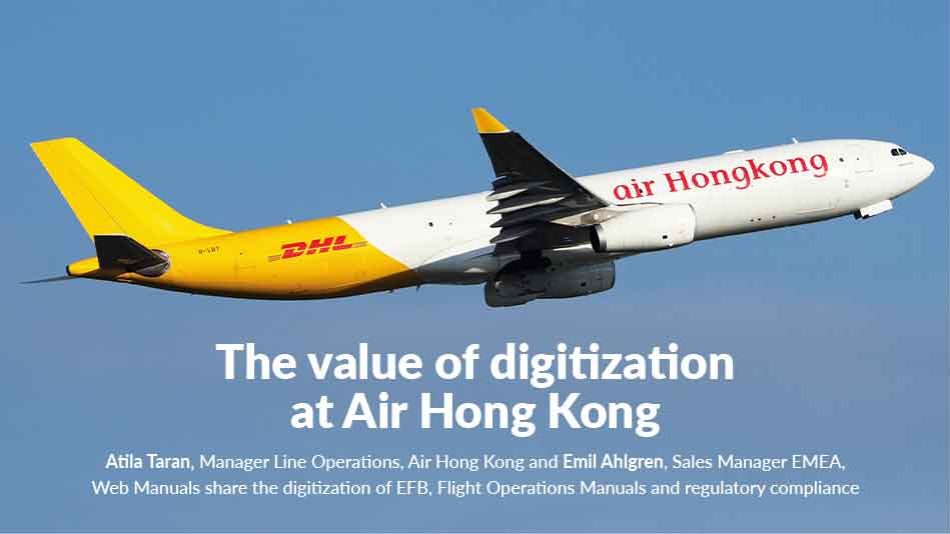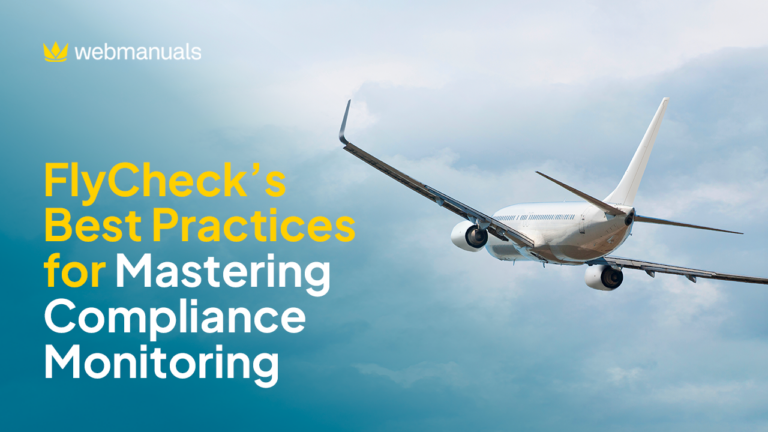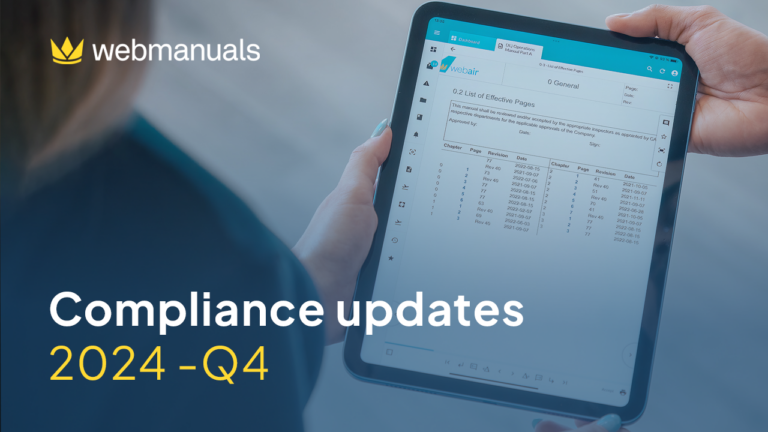In this Air Hong Kong case study, Atila Taran, Manager Line Operations, Air Hong Kong and Emil Ahlgren, Sales Manager EMEA, Web Manuals share the value of digitizing aviation manuals, including EFB application, operational control, and regulatory compliance.
Air Hong Kong is a small cargo business founded in 1986 in Hong Kong. The business has, in recent years, gone through numerous transformations. Stanly Ho, the ‘Casino King’ bought Air Hong Kong in 2002. At the end of 2002, DHL bought 40 percent of the business, rebranded Air Hong Kong and signed a fifteen-year joint venture agreement. The airline started with a freighter version of the Boeing 707 and a small fleet of Boeing 747-F types. The fleet now consists of ten Airbus A300-600F and A330-300 types mainly operated for DHL Aviation, with a couple operated by ASL Airlines Ireland.
Air Hong Kong serves thirteen major cities in Asia from the Hong Kong hub carrying mainly DHL Express cargo. This is the network (figure 1). The main purpose of this article is to share the journey of digitizing their aviation manuals and the implementation of an electronic flight bag (EFB application) for Air Hong Kong.
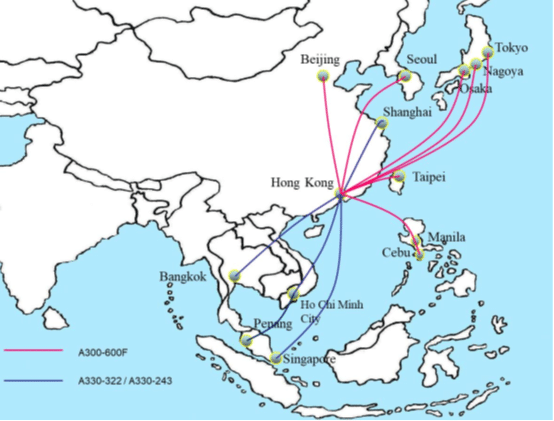
THE DIGITAL JOURNEY
Atila first heard about the EFB (Electronic Flight Bag) in 2009 at an Aircraft Commerce conference in Bangkok and found it so exciting a concept that he went back and reported on the development to the DFO (Director Flight Operations) and COO (Chief Operating Officer). The proposal suggested that Air Hong Kong adopt EFB technology. Development agreed but asked for a business case.
The challenge was how to make a business case for the digitizing of aviation manuals? Atila researched business case techniques and made a case for category 2 EFB for Air Hong Kong. After the initial research, the project had to stop because it was concluded too expensive. Air Hong Kong is a small operator with a simple operation with no cabin crew or dispatch function. However, Atila was not discouraged. She continued attending Aircraft Commerce conferences and learning about EFB.
THE AVAILABILITY OF EFB IN TABLETS
The tablet was first introduced for use in the EFB environment in 2015. The EFB application could then be installed on an iPad, Samsung Tablet or Microsoft Surface. With this change, the EFB project was restarted. In 2016, all Air Hong Kong pilots were given iPads. For two years, they were looking for applications and the right mounting for the aircraft. Then, in early 2018, the airline started an EFB trial. At the start of 2019, the Hong Kong CAD (Civil Aviation Department) granted approval for Air Hong Kong. They would use Navblue eChart as the chart type B software and Web Manuals for digitizing the aviation manuals.
However, the journey of digitizing their aviation manuals did not end there, as the EFB solution (figure 2) shows.
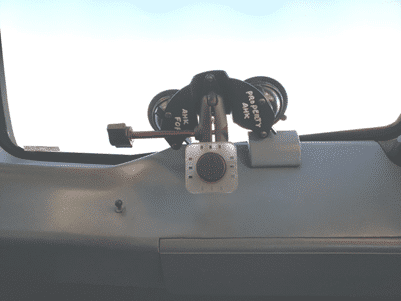
It’s very simple with RAM suction cups and Pivot cover, a simple solution but it does the job. Figure 3 shows the next project at Air Hong Kong. The EFF (Electronic Flight Folder) is an in-house Cathay Pacific application. The pilots at Cathay Dragon already use this application. Following a trial in early 2020, it will next be adopted for Air Hong Kong. If approved, Air Hong Kong will start using the application. It basically digitalizes all flight operations, NOTAM and weather.
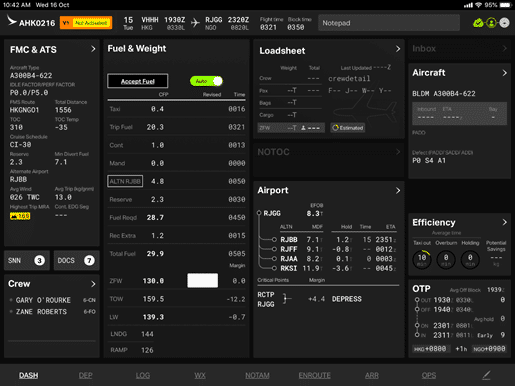
After the EFF project, the next project will be the eTech Log (ETL/ELB). There is still some way to go on Air Hong Kong’s journey to digitalization. Hopefully, by the end of 2020, the airline will be completely paperless.
FROM PAPER TO DIGITAL
In figure 4 is Air Hong Kong’s old system for managing aviation manuals, working with paper. As operators will know, it generates a lot of work and can take up to a month to revise an aviation manual on paper.
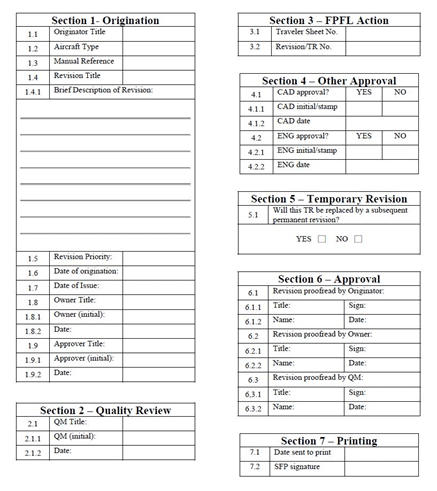
The aviation manuals revision need first to be recorded and those notes handed to Publications. In turn, they will draft them into a revised copy and return, in the case of Air Hong Kong, to Atila who will make further adjustments. They will then be sent them back for re-drafting, only to be returned again… Then each changed part of the manual has to be seen by the departments that it affects. They’ll come back with more corrections. It’s a lengthy process. Because of this, Air Hong Kong would often hold a number of revisions until there was enough material to create an aviation manual update.
WORKING WITH DOCUMENT LIFECYCLES AND WORKFLOWS
Using Web Manuals, this process has been cut to three or four days. The owners of a manual are able to go to the system right away and change the content within the manuals themselves; and that is all that needs to be done. The rest is completed digitally and automatically. The system includes the appropriate notations to ensure that the right revision is automatically replicated; wherever and in whatever aviation manuals it is applicable.
After the originator has completed the change, they’ll put the document into review; the reviewer will be notified and can go to the system to review the changes right away. Following the review, the reviewer will release the document to the final proofer. The final reviewer will proof it, approve it and clear it for publication. It’s a very simple system. Once the manual owner has clearance from the proofer, they can press the publish button. Within minutes, all pilots will receive notifications by email and can read the changed copy.
THE CHALLENGE OF STAYING COMPLIANT
The challenge of staying compliant is something that arises daily in our sector. Here, we want to share with readers the challenge of using inefficient tools. In the end, leading to qualified people doing unqualified things. We want to highlight the challenges of the traditional revision process that arises every day (figure 5).

First, you need to stay up-to-date with the latest published regulations by going to websites and other sources to see what has changed and/or is new compared to the old version in order that you can understand what that change entails. With that knowledge, you’ll update the compliance reference list in Excel to make sure that you have the right information according to what has changed or been added. The next stage is to undertake all the editing in Word, a lot of manual work to ensure that the structure is correct. It is important to be sure to update the revision bars and the revision number, and the revision dates.
THE BENEFIT OF AUTOMATIC MODULES
This is something that is done recurrently depending on how many updates you do. Subsequently, after the updates have been done it is also important to remember the cross-references. Cross-references are the links to the other documents that will be affected by the change – usually using a manual list to keep track. Next is to edit all the affected pages, table contents, the Change Log and list of effective pages. Then make the changes and also update the Revision Bars once again. Publish the PDF is the next job and to update the cross references to the documents to complete the compliance linking.
Before publishing the documents or generating the PDF, depending on whether each chapter is in a stand-alone file, it has to all be emailed for review. Hopefully, the reviewer will open and review the document and offer feedback, as requested by the compiler, which might, in turn, mean returning to the Word files to re-edit them followed by the whole content updating process, making all the updates, removing the Revision Bars and setting up new ones.
COMMON CHALLENGES FOR OPERATORS
That’s before continuing once more through the rest of the journey of digitizing aviation manuals. The goal is to hopefully be able to replace the old manual with the revised one. Then, sending an email to all recipients saying ‘here is a new revision that you need to check out’. This is a journey that Web Manuals hears about every day; it is what we mean when we talk about the value of digitizing aviation manuals.
For instance, some common challenges of using bad tools from operators before they become Web Manuals users are listed in figure 6.
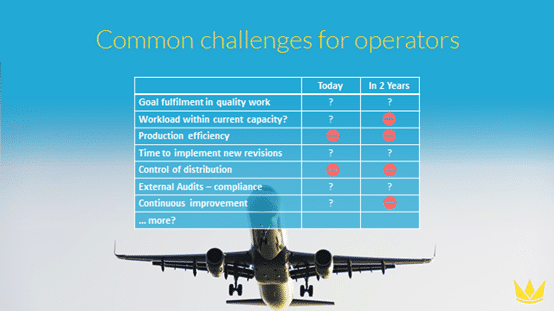
Now, we also need to keep in mind when considering digitizing aviation manuals; where are we today and where will we be in two years’ time? Maybe ‘goal fulfilment in quality work’ is something we can deal with today but, again, what will it look like in two years’ time? The ‘workload within current capacity’ might be OK today as companies strive to grow and do better. Yet, once more, what will it look like in two years? And do we need to plan for that? To illustrate the implementation times on new revisions; we have suggested that a month is what it takes using traditional tools and processes. Even if that’s OK today but how will we judge it in two years?
QUALIFIED WORK FOR QUALIFIED PEOPLE
On the whole, these are some of the operational challenges that we hear a lot about. We should try to ensure that qualified people do not spend their valuable time doing unqualified work. Accordingly, this Air Hong Kong case study highlights how tasks such as updating revision bars and changes to manuals are not qualified work.
About The Authors
Atila Taran
Atila joined Air Hong Kong in 2004 and joined the management team as Deputy Chief Pilot in 2007. Besides dealing with day to day operations in the fleet office, he also responsible for the test flight program and serves as A300-600F Senior Training Captain plus, in 2018, was given the responsibility to set up company’s paperless programme. Apart from his job as Manager Line Operations, he is also acting responsible manager for the EFB.
Emil Ahlgren
Emil has been dedicated to B2B sales since day one of his career and it’s easy to tell he thoroughly enjoys it. With years of experience working with B2B at Apple, Emil joined Web Manuals as a Sales Executive back in 2017 and a year later got promoted to Regional Sales Manager EMEA. Based in Malmö, Sweden.
Air Hong Kong
Air Hong Kong was founded in November 1986 and commenced charter services with a Boeing 707-320C freighter in 1988. The airline is the longest serving dedicated freighter airline based in Hong Kong and was the launch customer for a fleet of eight Airbus A300-600F General Freighters which entered into service between September 2004 and July 2006.
Web Manuals
Web Manuals specializes in developing digital document management solutions for the aviation industry. It is revolutionizing aviation manuals and regulatory compliance by making the digitization, authoring, and distribution of operational documentation easy and accessible to operators of all sizes.
What used to be a laborious manual task is now made simple: the rapid authoring, reviewing, publishing, distribution and control of an entire manuals library is now a seamless operation. This brings significant savings in time and administrative costs, while improving regulatory compliance and flight safety. Web Manuals is rapidly expanding its global footprint with more than 300 customers and partners worldwide, and offices in New York, San Diego and Malmö, Sweden.


